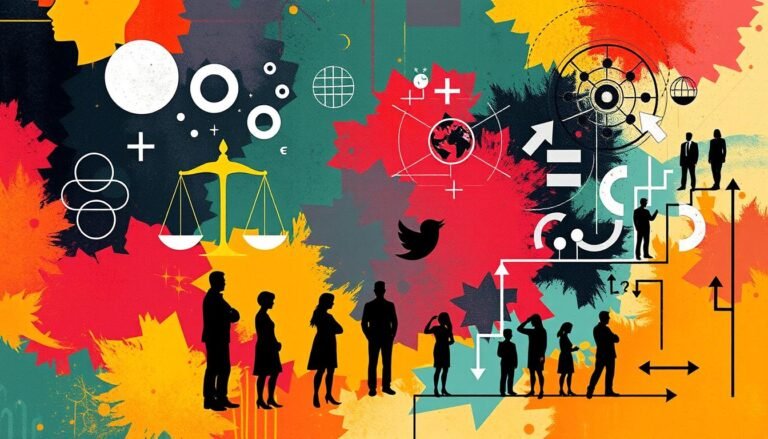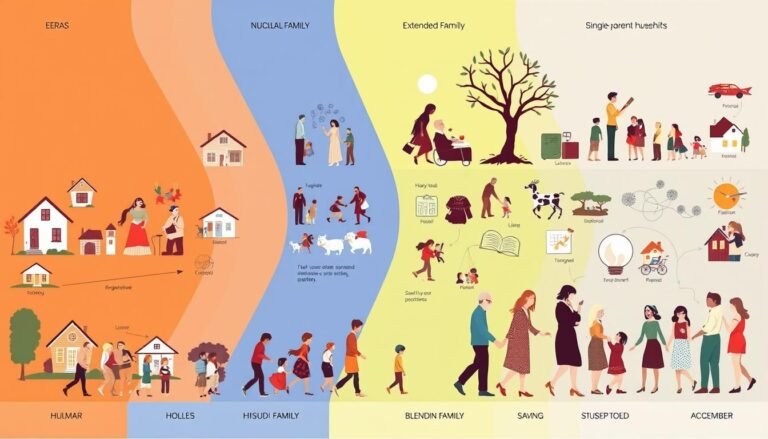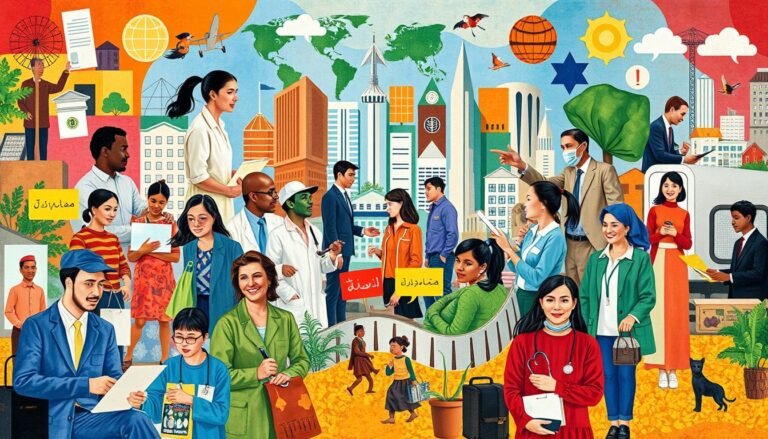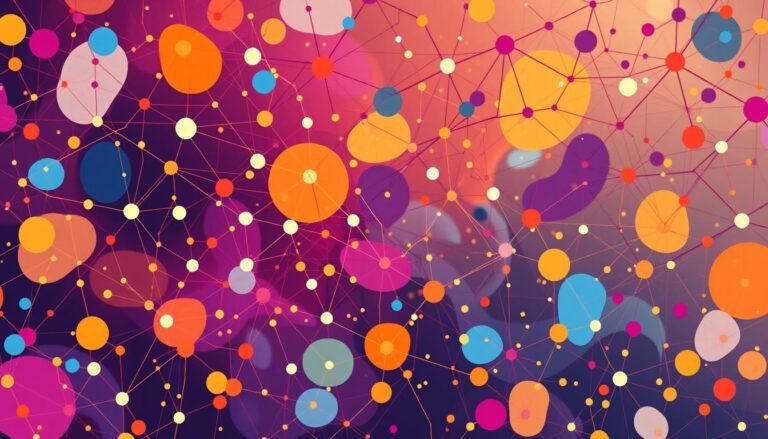The Role of Government in Social Welfare
Is the government’s role in social welfare a helping hand or a hindrance to personal growth? This question is at the center of a big debate. It affects policies that help millions of Americans. We’ll look into how government help has changed and its effects on society.
Social welfare programs are key in today’s society, helping millions of Americans. In 2020, over 62 million people got Social Security benefits. About 64 million used Medicare. These programs help a lot of people, with 70 million Americans getting Medicaid or CHIP.
The government plays a big part in social welfare. It managed about 30% of the Gross National Product in 2020. This means it put around one and a quarter trillion dollars into the economy. This makes people wonder about the balance between helping society and keeping individual freedom.
Even with these big programs, many Americans still face economic problems. Real incomes have dropped or been eaten away by inflation for up to 50% of workers in the last 20 years. Many people worry about falling behind, dealing with job insecurity and needing to always learn new skills.
Key Takeaways
- Government social welfare programs assist tens of millions of Americans
- The national government manages about 30% of the Gross National Product
- Economic challenges persist despite extensive welfare programs
- Downward mobility fears affect a significant portion of the population
- The debate continues on the balance between government support and personal responsibility
Understanding Social Welfare: A Historical Perspective
Social welfare in the United States has changed a lot over time. It started with the Elizabethan Poor Law of 1601. This law was the first step towards organized welfare programs.
The New Deal and Social Security Act
The 1930s were a big change for American social policy. President Franklin D. Roosevelt’s New Deal brought big changes. The Social Security Act of 1935 created a national system for retired workers.
It also helped those hurt in industrial accidents, the unemployed, and certain disabled people. Plus, it gave aid to mothers, children, and the disabled.
Expansion of Social Benefits (1942-1970)
After World War II, welfare programs grew fast. President Lyndon B. Johnson’s Great Society in 1964-65 aimed to fight poverty and racial injustice. It brought in big programs for education, healthcare, and more.
Post-Golden Era Challenges (1975-1995)
The late 20th century brought new challenges to social welfare. The economy and demographics changed, leading to debates on government’s role. There were efforts to reform welfare, balancing support with sustainability concerns.
| Era | Key Development | Impact |
|---|---|---|
| 1930s | Social Security Act | Established national old-age insurance |
| 1960s | Great Society | Expanded welfare programs |
| 1975-1995 | Welfare Reform | Debated government role in social welfare |
The Economic Foundations of Social Welfare Discontent
The roots of economic discontent in social welfare go deep. In recent decades, income inequality has grown, leaving many families struggling. Real incomes for a quarter to half of working families have dropped over the past 20 years. This wage stagnation has made people worry more about economic stability.
Job insecurity has gone up, thanks to technological changes in the workplace. The gap between high-skill and low-skill jobs has widened, affecting how people earn. Single-parent families are facing big challenges in this changing economy.
- Unemployment soared from 3.2% to 24.9% between 1929 and 1933
- Consumer spending fell 18%, manufacturing output dropped 54%
- 80% of automobile industry production stopped by 1932
Today, we see similar struggles. The growing income gap and ongoing wage stagnation lead to demands for social welfare changes. As technology changes the job market, fixing these economic issues is key for social stability.
| Economic Indicator | Great Depression | Current Era |
|---|---|---|
| Unemployment Rate | 24.9% (1933) | Varies, but lower |
| Income Inequality | High | Increasing |
| Job Security | Low | Declining |
| Wage Growth | Negative | Stagnant for many |
The Role of Government in Social Welfare
Government is key in shaping social welfare policies at all levels. It offers support to those in need through federal and state programs.
Federal Responsibility in Welfare Programs
Federal welfare programs are crucial in the U.S. The Supplemental Nutrition Assistance Program (SNAP) gives monthly funds for food. Medicaid also provides health insurance to low-income families, making sure they can get medical care.
State and Local Government Involvement
States have a big say in welfare policies. They handle things like energy subsidies, cash help, housing vouchers, and job training. The Temporary Assistance for Needy Families (TANF) program gives states block grants. This lets them use funds based on what their communities need.
Balancing Public and Private Sector Roles
Public-private partnerships are key in social welfare. The government provides a safety net, but the private sector adds efficiency and new ideas. For instance, over 155,000 angel investors and 50,000 venture capitalists help fund social businesses worldwide.
| Welfare Program | Description | Level of Government |
|---|---|---|
| SNAP | Food assistance | Federal |
| Medicaid | Health insurance | Federal/State |
| TANF | Cash assistance | State |
| Housing Vouchers | Housing assistance | State/Local |
Arguments Against Government-Sponsored Social Welfare
Some people don’t like government-sponsored social welfare programs. They worry about how they affect society. They talk about welfare dependency, the burden on taxpayers, and personal responsibility.
Potential Disincentives to Work
Some think welfare stops people from wanting to work. In England, 55% of people think unemployment benefits are too high and stop people from looking for jobs. Conservative groups say these programs make people too dependent and lower their drive to rely on themselves.
Taxpayer Burden Concerns
Welfare programs put a big load on taxpayers. In the U.S., health care programs in the welfare system use over a quarter of the federal budget and 5% of GDP. This big cost makes people wonder if it’s fair and if it’s sustainable.
Personal Responsibility vs. Government Intervention
Some say we should focus more on personal responsibility and less on government help. They think welfare might lead to more out-of-wedlock births and less motivation to work. The shame of getting public help can make people feel hopeless and stuck in poverty, especially for single moms.
“Traditional values of self-reliance amongst welfare recipients increase feelings of shame and stigma.”
But, it’s worth noting that poverty rates have gone down a lot since the 1970s. Now, about 15% of people are poor after getting welfare and tax credits. This shows that welfare programs can really help fight poverty.
The Case for Government-Supported Social Welfare
Government-supported social welfare is key in fighting poverty and meeting basic needs. It acts as a safety net for those in need, giving them freedom and choices. Some think welfare lowers work drive, but it often opens doors for more active community involvement.
Welfare is a vital support for many Americans. In 1995, the Aid to Families with Dependent Children program cost $17 billion, showing its wide reach. The change to block grants in 1996 let states customize welfare, possibly making it more effective.
Some say welfare makes poverty seem appealing, but that’s not the whole story. In 1982, 11.1 million people got AFDC benefits each month, with 7.5 million being kids. This shows how crucial welfare is for families and kids in need.
“Social welfare is not about creating dependency, but about providing opportunities for people to lift themselves out of poverty and contribute to society.”
The moral side of social welfare is strong. It’s our duty to prevent suffering and make sure everyone’s basic needs are met. Thinkers like Peter Singer believe we must support our most vulnerable, backing up the need for strong social support.
| Year | Program | Recipients | Cost |
|---|---|---|---|
| 1982 | AFDC | 11.1 million | $13.5 billion |
| 1981 | SSI | 4 million | $8 billion |
| 1995 | AFDC | N/A | $17 billion |
Human Rights and Basic Needs: The Ethical Dimension
Social welfare programs are built on ethical ideas and human rights. They see basic needs as key human rights. This idea guides many social welfare policies around the world.
Universal Declaration of Human Rights
The UN Universal Declaration of Human Rights lists food, clothing, housing, and medical care as basic rights. It sets a global standard for treating everyone fairly, no matter their wealth.
Moral Imperatives in Social Welfare
Social workers are key to following these ethical standards. The National Association of Social Workers (NASW) Code of Ethics stresses the need to fight for living conditions that meet basic human needs. It calls for social and political action to make sure everyone has equal access to resources and chances.
“Social workers promote social justice and social change with and on behalf of clients.”
The health sector also has a big role. It aims to improve population health with a 5-point plan. This plan includes using human rights in health actions, making sure everyone has basic health care, and making healthcare financing fair.
| Ethical Considerations | Actions |
|---|---|
| Prevent exploitation and discrimination | Act against bias based on race, ethnicity, gender, etc. |
| Promote social justice | Expand opportunities for disadvantaged groups |
| Ensure basic needs | Advocate for adequate living conditions |
These ethical ideas in social welfare highlight the need to stop suffering. They aim to make sure everyone’s basic needs are met. It’s about balancing individual rights, social duties, and the fight for social justice.
Welfare Reform: From Entitlement to Block Grants
The 1996 Personal Responsibility and Work Opportunities Reconciliation Act changed welfare forever. It moved from entitlement programs to block grants. This gave states more control over welfare policies, leading to different approaches nationwide.
States then focused on helping people find jobs quickly. Work participation rates soared, especially in states with federal waivers. By 1999, states were spending about 55% of their welfare budgets on cash help. More money went to work supports like childcare and transportation.
- Minnesota offered financial incentives to work
- Michigan emphasized employment services
- Kansas provided a mix of services for various family needs
- Texas stressed independence from public assistance through strict requirements
The change from entitlement programs to block grants had big effects. About 42% of welfare recipients could lose benefits under similar proposals. Another 30% might see their benefits cut. These changes aimed to save nearly $70 billion over five years.
| Impact Area | Percentage Affected |
|---|---|
| Potential Benefit Loss | 42% |
| Reduced Benefits | 30% |
| JOBS Program Participation | 23% |
This welfare reform aimed to promote work and reduce dependency. But, it also raised concerns about its impact on the poorest Americans. They receive just 4% of total U.S. income. The long-term effects of this shift continue to shape social welfare policies today.
The Impact of Welfare on Poverty and Income Inequality
Welfare programs are key in fighting poverty and spreading wealth more evenly. A review of 17 studies in 10 rich countries shows how well they work. This research got a lot of attention, with 69,000 views and 50 references, showing its importance.
Effectiveness of Welfare Programs
The review found mixed results on welfare’s success. While it aims to help the poor, 13 studies showed that those getting social help often had poorer health than those who didn’t. This shows the complex link between welfare and health.
But, welfare has helped reduce poverty. In 2000, the poverty rate for those born in the U.S. was 11.9%, and for immigrants it was 17.8%. After welfare benefits were factored in, these rates fell to 11.1% and 17.3% respectively. This shows how welfare can make a difference.
Long-term Economic Consequences
The long-term effects of welfare policies are big. After the 1996 welfare reform, which changed Aid to Families with Dependent Children (AFDC) to Temporary Assistance for Needy Families (TANF), some trends appeared:
- Immigrant families most affected by welfare reform increased their work effort a lot
- Cash from welfare was less good at making income more equal
- Tax and in-kind benefits helped make income more equal until the Great Recession
These findings show the complex ties between welfare policies, fighting poverty, and making income more equal. As the U.S. moves towards more in-kind and tax benefits over cash, policymakers need to think about the long-term effects on poverty and inequality.
| Year | Native Poverty Rate | Immigrant Poverty Rate | Adjusted Native Poverty Rate | Adjusted Immigrant Poverty Rate |
|---|---|---|---|---|
| 2000 | 11.9% | 17.8% | 11.1% | 17.3% |
Balancing Freedom and Social Responsibility
The COVID-19 pandemic has made us think hard about the balance between our freedom and our duty to others. This balance is key in welfare ethics. It makes us question how to protect everyone’s rights while also looking out for the common good.
Public servants deal with this issue every day. Police, park rangers, and healthcare workers must decide between protecting us and respecting our rights. During the pandemic, small business owners had to choose between staying safe and keeping their businesses afloat.
The argument over stay-at-home orders versus reopening shows how hard this balance is. It shows the tricky relationship between citizens and their government, especially in tough times. Public servants often get criticized no matter what they do.
A recent court ruling in Florida made things even harder. It said the government can’t make people wear masks on public transport. This decision makes us wonder how we’ll handle health threats in the future. It shows the ongoing fight between our personal rights and the need to protect everyone.
“The necessity of a legitimate governing authority to address contentious issues between freedom and social welfare is highlighted.”
As we work through these issues, we must think about how they affect different groups of people. The pandemic and its measures have hit some communities harder than others. This shows we need to find ways to balance our personal freedoms with our duty to society.
| Aspect | Individual Freedom | Social Responsibility |
|---|---|---|
| Health Measures | Personal choice in mask-wearing | Protecting vulnerable populations |
| Economic Impact | Business reopenings | Preventing virus spread |
| Government Role | Limited intervention | Public health protection |
The Future of Social Welfare: Challenges and Opportunities
Social welfare is changing fast, thanks to economic changes, new tech, and shifts in population. We need to update our welfare policies to keep up with these changes.
Adapting to Economic Changes
It’s key for social welfare to adjust to economic changes. For example, Uganda has cut poverty from 56% in 1992 to 20% in 2022 with smart policies. But, there are still hurdles. In Brazil, the gap between the rich and the poor has grown, with the top earners making 38 times more than the bottom.
Technological Impacts on Employment
Automation is changing jobs, making unemployment due to technology a big worry. To tackle this, we should focus on education and training. Costa Rica plans to spend 8% of its GDP on education, helping migrant kids get included fast.
Addressing Demographic Shifts
Populations are aging and family structures are changing, which means we need new welfare solutions. Portugal is putting more money into helping children fight poverty. Trinidad and Tobago is setting up a National Register of Vulnerable Persons.
| Profession | Median Annual Salary (May 2022) |
|---|---|
| Mental Health Counselors | $49,710 |
| School Counselors | $60,140 |
| Community Health Workers | $46,190 |
We’re facing big challenges, but it’s important to remember that the top 10% of people own 76% of the world’s wealth. We need welfare policies that aim for fairness, support growth, and improve society for everyone.
Global Perspectives on Government’s Role in Social Welfare
Around the world, governments are key in shaping social welfare policies. The World Bank plans to give nearly $29 billion to social protection and jobs in 2024. But, 4.1 billion people still don’t have access to proper social protection systems. This shows we need stronger international welfare systems.
Comparing social policies across countries shows big differences. In the U.S., 65% think the government should make sure everyone has healthcare. But, not all countries have this system. The way countries handle social security also varies a lot.
The future of social welfare is changing and going digital. The COVID-19 pandemic showed how important it is to have systems that can quickly adapt to crises. With the global working-age population set to grow by 700 million by 2035, governments must invest in people and handle the aging population. This will greatly influence social policies for the future.
Source Links
- Redefining the Federal Role in Social Welfare: 1995
- Understanding Social Welfare Policy
- What is Social Welfare History?
- Understanding social welfare : a search for social justice – Catalog
- 9780205179701 – Understanding Social Welfare A Search for Social Justice by Ralph Dolgoff | eCampus.com
- Great Depression: American Social Policy
- The Political Economy of Social Welfare: A Perspective
- On welfare pluralism, social policy and the contribution of sociology: Revisiting Robert Pinker
- Social Welfare System: Definition and How It Works
- The Role Of Government In Promoting Social Welfare – FasterCapital
- Criticism of welfare
- The Shortcomings of a Work-Biased Welfare System
- The Advantages and Disadvantages of Different Social Welfare Strategies
- Welfare: Social and Individual Responsibility
- State-Federal Welfare Relationships
- Social Workers’ Ethical Responsibilities to the Broader Society
- Human Rights and Ethics in Public Health
- Code of Ethics: English
- Is Devolution Working? Federal and State Roles in Welfare
- An Analysis of the Issues
- The impact of social assistance programs on population health: a systematic review of research in high-income countries – BMC Public Health
- Does welfare reduce poverty?
- The Role of Welfare in Family Income Inequality: 1968-2016
- Balancing Freedom and Responsibility on the Front Lines of Public Service
- What Do We Owe Each Other? Balancing Personal Freedom and Collective Responsibility in the Age of COVID
- Balancing individual freedom, privacy and social responsibility in times of crisis
- Reviewing Welfare System Challenges, Lessons Learned during Recent Crises, Speakers Tell Ministerial Forum Investing in Children Key for Economic Growth, Well-Being
- Current Issues in Social Work
- Overview
- 2. Americans’ views of government aid to poor, role in health care and Social Security
- Thesis







